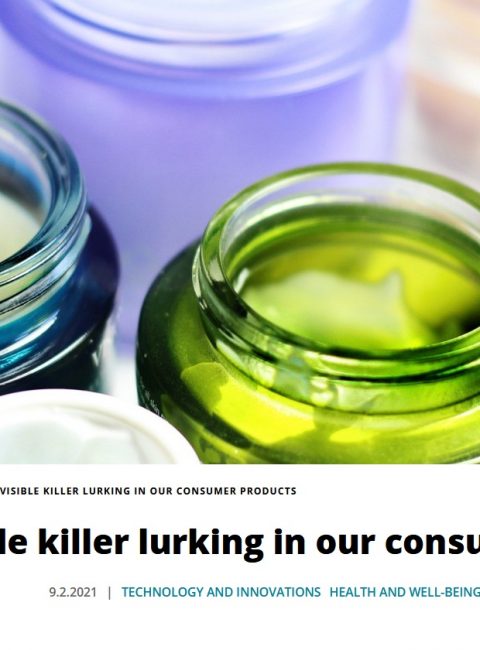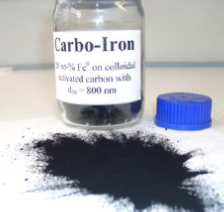 >
Spotlight April 2021: Nanomaterials and Fake News – a commentary based on an example
>
Spotlight April 2021: Nanomaterials and Fake News – a commentary based on an example
In February 2021, the article “The invisible killer lurking in our consumer products” appeared, describing nanoparticles as a greater danger than Corona [1]. “The use of nanomaterials” would be “unregulated” and “nanomaterials are so small that they cannot be determined once they are part of a product”. So what is the truth of these statements?
The article refers to a publication by Monikh et al. in which the transport of gold particles within the aquatic food chain from algae to daphnia to fish was studied [2]. To understand the uptake, accumulation and distribution of nanogold particles, both the number of particles and the mass were determined. The authors were able to show that only a small proportion of the gold particles ingested by algae were detectable in the fish (0.03%- 0.48%) and that a large proportion of the gold was excreted (49-58%).
The scientific achievement of this study lies in the development of a reliable method to determine the transfer of nanomaterials in a food chain. The transformation of the particles during their transfer through different organisms is taken into account (size, solubility). It is also possible to determine exactly in which parts of an organism particles are found and whether there is an accumulation via the food chain (which is not the case). The gold nanoparticles which were used should be considered as model particles, which were selected because of their good detectability. A general statement regarding the transfer of other nanomaterials through food chains cannot be derived from this.
In the publication by Monikh et al. no comparison was made with Corona and the allegedly non-existent regulation of nanomaterials is also not mentioned. Why then is it mentioned in the article on chemeurope.com?
One possible explanation could be that lurid and emotionally written texts reach a larger number of readers and are shared more often. Texts that play with human fear and generate the signal “danger” in the readers mind, spread faster. In the case of the example text, it is already clear from the headline that the word “killer” creates fear and that “our consumer products” are intended to address a broad target audience. Fake news is characterised by making claims that are not proven (no source is cited) or that statements are greatly reduced and thus a false picture is reproduced. Therefore, it is worthwhile to look at the original sources (if available).
In the case of the article, parts have been corrected (namely the sentences mentioned above), but the original article as well as the German translation is still available on chemeurope.com and the reference to the cited scientific study remains unclear [3,4].
Original publications:
[2] Abdolahpur Monikh, F., Chupani, L., Arenas-Lago, D. et al. Particle number-based trophic transfer of gold nanomaterials in an aquatic food chain. Nat Commun 12, 899 (2021).
[3] https://www.uef.fi/en/article/the-invisible-killer-lurking-in-our-consumer-products

Weitere Spotlights
Spotlight April 2022: A new risk assessment of nanomaterials in 3D printing is needed
The use of nanomaterials in 3D printing has great potential. Due to the properties of nanoscale materials, many requirements can be implemented in 3D printing. However, these unique properties based on the size of the particles also lead to the need for new risk assessments. This is because if the nanoparticles are released in the […]
Read moreSpotlight September: A methodology for the automatic evaluation of data quality and completeness of nanomaterials for risk assessment purposes
This paper describes a method for automatically assessing the quality and completeness of nanosafety data for the purpose of risk assessment. Steps to develop the methodology for assessing data completeness and the methodology for assessing quality are presented. The methodology is tailored to physicochemical and hazard (meta) data, but can also be configured with appropriate […]
Read moreSpotlight September 2020: Groundwater remediation with Carbo-Iron® – Risk or Benefit?
In September we would like to present a paper of the BMBF project Fe-Nanosit. The project dealt with the use of iron-containing nanomaterials in groundwater and wastewater remediation. A comprehensive assessment and weighing of benefits and possible environmental risks resulting from the application is now presented by the project partners in this paper. Groundwater is indispensable for the […]
Read moreSpotlight August 2021: Towards FAIR nanosafety data
In August we would like to present a paper on FAIR data. The paper published in Nature Nanotechnology in June 2021 summarises the challenges and provides recommendations for the efficient reuse of nanosafety data in line with the recently established FAIR guiding principles: findable, accessible, interoperable and reusable. This article summarises the know-how on the […]
Read more


